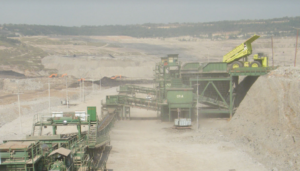Two of the most experienced global experts in in-pit crushing and conveying (IPCC) technology application in mining are Phil Morriss and Doug Turnbull, who amongst other positions formerly held have been Sandvik VP Mining Technical Services and Principal Mining Engineer, Sandvik Mining Systems, respectively, but have also completed extensive work on a consultancy basis specialising in IPCC.
Both have their own personal consultancies but are now also lending their expertise to Snowden Group – now part of Datamine; Morriss (himself also previously Snowden Group Manager Mining) as Associate Executive Consultant and Turnbull as Associate Principal Consultant. They have been involved at one time or another with many of the world’s largest IPCC projects, from S11D to Mae Moh.
And their arguments – in one form or another outlined on several occasions at IM‘s regular IPCC conferences, remain compelling. Open pits are getting deeper requiring lower mining cost solutions, and there is increasing pressure on mining companies to reduce carbon emissions. “IPCC is a potential solution for both issues. And when we say potential, we mean that it will not work for every case. However, in those cases where it makes sense, the economic and environmental benefits can be significant.”
Snowden, and its IPCC team, has completed at least 40 IPCC studies worldwide and says it is “well placed to help you understand, at a desktop through to pre-feasibility level, whether IPCC might be of benefit to your operation.”
Summarising the concept, the authors and Snowden outline in a recent article that the intent of IPCC is to convert as much of your material haulage from trucks (and their associated manning, fuel, maintenance, tyres and capital cost) to conveying. “IPCC reduces capital and operating costs by a combination of switching manning from truck operators and maintenance to a single, more automonous system requiring less personnel; replacing diesel consumption with electricity; reducing the number of trucks you need in the mine (both peak and replacement); and reducing the associated ancillary equipment fleet.”

Mae Moh lignite mine, Thailand. Image courtesy Italian-Thai Development Ltd
It adds: “For these benefits, there is an upfront capital investment and an ongoing operating cost associated with the IPCC system and changes required to your mine plan. In order to convey material, it must first be crushed or sized. IPCC can be completed for both ore and waste, although the benefit with ore is typically greater as crushing waste is ‘dead money.’
What are the potential benefits? Through the numerous studies completed into IPCC, Snowden says it has found the following typical results:
- Cash cost reduction of between US$0.18/t and US$1.00/t
- Best Net Present Cost (NPC) improvement – $800 million (@9% discount)
- Typical truck savings from 20 to 60% of fleet
- Typical reduction in manning – averages 6.5 persons per truck saved
- Typical reduction in ancillary equipment – 30%
- Reduction in infrastructure costs associated with workshops
- Overall capital for long life mines is either near neutral or in favour of IPCC when truck replacements are considered.
- Reduction in on-site carbon emissions by up to 50% depending on power source.
Snowden argues that there are four main types of IPCC:
Fixed ex-pit (EPCC): Where a crusher is located outside the pit rim and is used to reduce long ex-pit hauls.
Fixed in-pit: Where a crusher is located inside the pit rim, at a fixed location (final wall) to increase the haulage savings from EPCC.
Semi-mobile: Where a crusher is located inside the pit rim, and moves semi-regularly to new positions to maximise the haulage savings.
Fully-mobile: Where the crusher (sizer) is directly loaded by a shovel, eliminating the need for trucks.
“The planning complexity increases between each type of IPCC, with fully mobile being generally the most complex in metalliferous mines. Determining the best option for your operation(s) is key to the potential for successful implementation.” So what does IPCC do to your mine plan? “The impact on IPCC depends on the type of IPCC system being implemented. However, Snowden says the types of impacts include pit re-design. “Unless you are using EPCC, your pit will need some redesign to accommodate the crusher pocket and conveying route. The conveyor may have a dedicated route, or be placed alongside an existing (but widened) haul route. Where possible the conveyor route should be as straight as possible to minimise transfer points. Additionally, you may need to adjust your pit stages to provide connections between phases or pits that minimise the number of crusher moves.”
On scheduling Snowden argues you may need consider additional material movement in your schedule, or optimise your schedule to maximise the tonnage reporting to your IPCC system. And IPCC waste dumps require detailed planning and can be difficult to integrate into existing operations. Often trucked waste will be required to prepare the IPCC waste dump ahead of commencement. “The ability to manage multiple waste types in a dump is limited and complex waste dump shapes must be avoided, as they will increase the number of conveyor movements and reduce system capacity.”
Will IPCC work for your mine? The benefits of IPCC depend on the specific conditions. Snowden’s view is that IPCC tends to favour:
- Longer hauls: Usually a minimum cycle time of at least 15 mins (in a pit stage or group of pit stages) is required, depending on the price of generated electricity.
- Tonnage: Usually a minimum of 20 Mt/y is required to be moved from a pit stage (or group of connected pit stages). This needs to be separated by ore and waste (as they will typically use different IPCC systems).
- New project or operation where existing truck fleet does not need to be replaced.
- Low electricity unit costs and/or high fuel costs
- High labour costs
- Minimal rock types: IPCC is more challenging when you have to blend ore, or manage waste materials (such as acid generating rock).
- Lower rock strengths: This enables a greater throughput to crusher/sizer ratio.
- Organisation needs to be open to change: IPCC often fails due to the inability of leadership to accept the necessary operational paradigm changes to make it successful.
- High priority on reducing carbon emissions
“Of course, not all these items need to be favourable for IPCC to be of benefit, but the more the better…Snowden has developed the expertise required to optimise mine designs and schedules for the application of IPCC. The Snowden IPCC team includes experts in IPCC strategy, IPCC engineering and mine planning. We specialise in desktop, scoping and PFS level assessments of IPCC potential for new or existing mines.”
It adds: “In an initial assessment, we will review a base case (truck only) mine plan developed by you; identify a potential IPCC strategy(s) that may lead to a positive economic/environmental outcome; assess the potential risk factors that would limit the IPCC potential; assess the impact of the IPCC strategy on the mine plan; estimate the potential truck savings resulting from the IPCC strategy; estimate the cost (operating and capital) for the proposed IPCC solution (in conjunction with IPCC suppliers); and evaluate the potential economic and environmental benefit through differential analysis to the base case plan. Such assessments can typically be completed within a month, depending on the complexity and the detail required. Snowden can then assist with mine planning and detailed IPCC strategic support if your project progresses beyond initial study level.”
Looking in more depth at the team’s background – Morriss has over 46 years of experience in open pit mining, including: 25 years of large open pit precious and base metals operations with Rio, BHP Billiton and Placer Dome in a range of technical and managerial roles in Australia, Papua New Guinea, South America and Africa; four years as General Manager then CEO of an international mining contractor operating in Ghana and Tanzania in Africa; and 17 years as an international mining and geotechnical consultant, and a specialist in-pit crushing expert. He has a strong technical background which has included the publication of many papers on probabilistic rock slope stability, final pit wall blasting, trolley assisted truck haulage, contractor vs owner mining, and in-pit crushing and conveying (IPCC). He has also run workshops on pit slope stability (with Evert Hoek), managing mining contracts, understanding risk in mining, and IPCC. And as stated he managed the global mining division activities for the Snowden Group and expanded its international operations.

Phil Morriss
Turnbull is a Mining Engineer by training. He started his career at Teutonic Bore underground copper/zinc sublevel open stope mine in Western Australia in 1980 as a longhole production driller. Doug has worked in many facets of the mining industry since then, including drill & blast crew, shotfirer, shiftboss, mine planning engineer, mining production manager, processing production manager, fixed & mobile equipment maintenance manager, supply chain manager & study manager across a number of commodities including iron ore, aggregates, coal, copper, gold & manganese mines. He extended his experience into mining equipment supply and services on a global basis, including at Sandvik as Head of Trans4mine (customer applications optimisation fitting the mine plan to the equipment including in-pit crushing & conveying assessments in surface mining and automated equipment assessments in underground mining) & Vice President of Mining Systems. He says this background has provided a strong global network together with an understanding of what works and what does not.

Doug Turnbull











